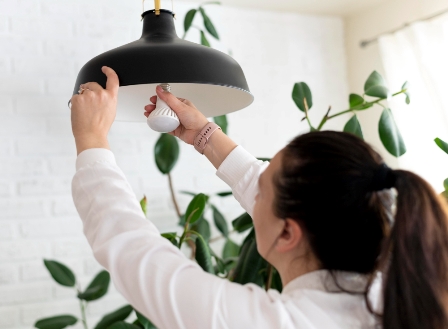Basements often remain underutilized, but they hold the potential to be transformed into comfortable, functional living spaces. One exciting possibility is converting your basement into a bedroom. In this article, we’ll explore the numerous ideas and considerations involved in creating a basement bedroom that is not only cozy but also meets all the essential requirements.
Make Use Of Existing Space

Our homes are filled with untapped potential. The key to making the most of your existing space is to think creatively, envision possibilities, and consider the unique needs of your household. From attics and basements to hallways and closets, there are numerous areas waiting to be transformed into something practical and enjoyable.
Multi-Functional Furniture:
Opt for furniture pieces that serve more than one purpose. For example, a sofa bed can function as both a seating area and a guest bed, making it a versatile addition to your space.
Wall-Mounted Shelving:
Utilize vertical space by installing wall-mounted shelves. These provide storage without taking up valuable floor space, making them ideal for smaller areas.
Under-Stair Storage:
If you have a staircase, consider utilizing the space underneath for storage. Custom-built cabinets or drawers can transform this often-overlooked area into a practical storage solution.
Closet Organizers:
Make the most of your closet space by installing organizers, including shelves, drawers, and hanging rods. This can help keep your belongings tidy and easily accessible.
Fold-Down Tables:
In areas with limited space, such as a kitchen or home office, a fold-down table can be a space-saving solution. When not in use, it can be folded against the wall to create more room.
Built-In Furniture:
Custom-built, built-in furniture can be tailored to fit the exact dimensions of your space. This ensures every nook and cranny is used efficiently.
Layer Your Lights

Creating a well-lit and inviting space involves more than just flipping a switch. To achieve the perfect ambiance and functionality, consider layering your lights. This approach combines different types of lighting to add depth, warmth, and versatility to your environment. Here are the key layers of light to consider:
Ambient Lighting
(General Lighting): This is the primary source of light that illuminates the entire room. Ceiling-mounted fixtures like chandeliers, pendant lights, or recessed lighting are common choices. The goal is to evenly distribute light and provide a comfortable baseline illumination.
Task Lighting:
Task lighting is designed to illuminate specific areas or tasks, making it easier to perform activities such as reading, cooking, or working. Examples include desk lamps, under-cabinet lighting, and pendant lights over a kitchen island. Task lighting should be bright enough to reduce eye strain without creating glare.
Accent Lighting:
Accent lighting is used to highlight particular features or elements within a space, such as artwork, architectural details, or decorative objects. Track lighting, wall sconces, or spotlights are ideal for this purpose. The focused beams draw attention and add a touch of drama.
Mood Lighting
(Decorative Lighting): Mood lighting, often achieved through table lamps, floor lamps, or wall-mounted fixtures, sets the tone and adds a cozy, intimate feel to the room. It’s particularly important in living rooms and bedrooms, creating a welcoming atmosphere.
Natural Lighting:
Whenever possible, maximize natural light by using windows, skylights, or glass doors. Natural light not only reduces energy consumption but also provides a connection to the outdoors, enhancing the overall ambiance.
Dimmers:
Installing dimmer switches allows you to adjust the brightness of various light sources to suit different occasions and moods. Dimmers offer flexibility and can transform a room from vibrant and lively to relaxed and soothing.
Incorporate Insulation
When it comes to optimizing your living space, incorporating insulation is a critical aspect that often goes unnoticed. Proper insulation offers a wide range of benefits, from energy efficiency to comfort and even soundproofing. Here’s how you can effectively incorporate insulation into your space:
Wall Insulation:
Consider adding insulation to your exterior walls. This helps maintain a comfortable indoor temperature by preventing heat loss in winter and heat gain in summer.Insulation materials can include fiberglass batts, foam board, or blown-in insulation, each with its own advantages and R-values (thermal resistance).
Ceiling and Roof Insulation:
Insulating the attic or roof space is crucial for energy efficiency. Proper attic insulation can reduce heat transfer and lower your heating and cooling costs.Options for attic insulation include fiberglass or cellulose insulation, which can be blown in or installed as batts.
Floor Insulation:
If your living space is above an unconditioned space like a garage or crawlspace, insulating the floor can enhance comfort and energy efficiency.
Windows and Doors:
Properly seal gaps around windows and doors with weatherstripping and caulk. This prevents drafts and enhances insulation.
Sealing Air Leaks:
Identify and seal any gaps, cracks, or holes in walls, ceilings, and floors. Air leakage can significantly impact energy efficiency and comfort.
Professional Assessment:
For a comprehensive approach, consider hiring a professional insulation contractor to assess your space and recommend the most suitable insulation materials and techniques.
Making the Most of Natural Light
Natural light can transform the ambiance of any living space, making it feel open, inviting, and vibrant. To maximize the benefits of natural light in your home, follow these strategies:
Clean and Position Windows:
Ensure windows are clean to allow maximum light to filter through. Position furniture and decor to avoid obstructing light.
Choose Light-Reflective Colors:
Opt for light and neutral wall colors, as they reflect natural light and make the room feel more spacious.
Use Mirrors:
Place mirrors strategically to bounce light around the room. This creates the illusion of more light and space.
Sheer Curtains or Blinds:
Use sheer curtains or blinds that can filter light while maintaining privacy. Avoid heavy, light-blocking curtains in rooms where you want more natural light. If you need help in installing and choosing the right type of window blinds for your home, click here.
Maximize Ventilation: A Guide to Enhancing Airflow and Comfort in Your Home
Good ventilation is essential for maintaining a healthy, comfortable, and fresh indoor environment. To maximize ventilation in your living space, consider the following tips:
Natural Ventilation:
Take advantage of natural ventilation by opening windows and doors, especially during cooler mornings and evenings.
Cross-Ventilation:
Create cross-ventilation by opening windows on opposite sides of your home. This allows fresh air to flow through, cooling your space.
Storm Windows and Doors:
Storm windows and doors can help improve insulation while allowing you to open the primary windows and doors for ventilation.
Use Exhaust Fans:
In areas like kitchens and bathrooms, use exhaust fans to remove excess moisture and odors. Make sure they vent to the outside.
Consider Waterproofing
Waterproofing is a crucial aspect of home maintenance, as it helps protect your living space from water damage, mold, and structural issues. To ensure your home is effectively waterproofed, consider the following:
Exterior Waterproofing:
Start with the exterior of your home. Ensure that your foundation is properly sealed and that there are no cracks in the walls. Use waterproofing coatings or membranes to protect against moisture infiltration.
Gutters and Downspouts:
Keep your gutters and downspouts clean and well-maintained. Proper drainage of rainwater is essential to prevent water from accumulating near the foundation.
Landscaping:
Proper landscaping can help direct water away from your home. Ensure the ground slopes away from the foundation, preventing water from pooling near the structure.
Basement Waterproofing:
If you have a basement, invest in basement waterproofing solutions, such as interior or exterior drain systems, sump pumps, and moisture barriers.
Explore These Unfinished Basement Bedroom Ideas
Turning an unfinished basement into a cozy and functional bedroom is an excellent way to maximize your living space. Here are some creative ideas to help you transform your unfinished basement into a comfortable bedroom:
Moisture Control:
Before you start any renovation, address moisture issues by sealing any cracks, waterproofing the walls, and ensuring proper drainage.
Proper Insulation:
Insulate the walls and ceiling to regulate temperature and reduce energy costs. This step is vital for comfort and energy efficiency.
Flooring:
Choose a flooring material that is moisture-resistant. Options include vinyl, laminate, or moisture-resistant carpet. Consider using area rugs for added comfort.
Ceiling Treatment:
To maintain ceiling height and accessibility to utilities, consider painting or staining the ceiling joists and ductwork for an industrial-chic look.
Partition Wall:
If your basement is large, you can create a partition wall to separate the bedroom from other areas. This wall can be partially finished or include shelving for storage.
Bed Nook:
Create a cozy bed nook by framing the area with curtains or decorative screens. This adds a sense of privacy and separation from the rest of the space.
FAQs
Here are answers to some frequently asked questions about Basement Bedroom Ideas
To make your basement bedroom look good, focus on proper lighting, use light and neutral color schemes, incorporate stylish decor, and ensure that the space is well-organized and clutter-free. Adequate natural and artificial lighting, in particular, can greatly enhance the aesthetics of the room.
Yes, it’s absolutely okay to have a bedroom in the basement. Many homeowners successfully convert their basements into bedrooms. However, it’s essential to address safety, ventilation, and legal requirements, such as egress windows, to ensure the basement bedroom meets building codes and offers a safe and comfortable living space.
Converting a basement into a bedroom involves several steps, including assessing the space for moisture and insulation, addressing any moisture issues, insulating walls and floors, installing proper lighting, ensuring ventilation, and decorating the space to make it comfortable. You may also need to consider egress windows for safety and legal compliance.
Decorating a dark basement bedroom involves using light and neutral colors to brighten the space. Incorporate ample artificial lighting, including task lighting, and consider reflective surfaces like mirrors to enhance light distribution. Choose light-colored furniture and decor, and add indoor plants to bring life to the room.
The best color for a basement bedroom is generally light and neutral tones, such as pale gray, beige, soft blue, or off-white. These colors reflect light and create a brighter and more open atmosphere, which is especially important in a basement with limited natural light.
To make your basement bedroom cozier, incorporate soft and comfortable bedding, plush rugs, and warm, inviting colors. Add personal touches with decor, like family photos and artwork. Use curtains or drapes for a warm and cozy feel, and consider adding a small reading nook or seating area to make the space inviting and comfortable.
Conclusion
your basement holds immense potential, and converting it into a bedroom can be a rewarding project. With proper planning, design, and attention to detail, you can create a basement bedroom that’s not only functional but also a cozy retreat for you, your guests, or your children.


